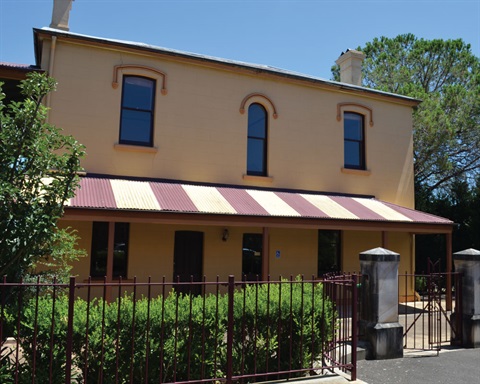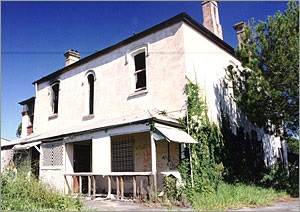The Parsonage

The land to build a residence for the Minister of the Wesleyan Church, located directly to the east between Turner Street and Church Street Ryde, was purchased in March 1883. The Parsonage (sometimes also referred to as The Manse) was completed and the Minister, Reverend Davis moved in February/March 1885.
The Parsonage's original presentation was to Devlin Street, with a formal garden that gently sloped down towards Devlin Street. However, the gradual development of Devlin Street, as a major transport spine, required road realignment and widening that eventually culminated in The Parsonage's main presentation being towards Turner Street. Turner Street was constructed in about 1915, and once had the unseemly reputation as being a venue for cock fighting! Both The Parsonage and Westward Cottage, at 8 Turner Street, Ryde, are now in elevated positions in relation to Devlin Street, through the construction of the Victoria Road underpass.
Over the years, through changes in ownership and usage, The Parsonage was poorly adapted and turned into a number of flats before coming into the Roads & Traffic Authority of NSW's (RTA) ownership in 1990, as part of the grade separation project for Victoria Road and Devlin Street, Ryde.

The Parsonage is a substantial high Victorian quality house that was well constructed through the use of quality materials and workmanship. The Parsonage has masonry external walls, timber floors and roof framing with a slate roof covering. The building has a simple rectangular form with a separately roofed two storey verandah on two sides and a single storey verandah to its rear (Turner Street presentation). The hipped slate clad roof features four rendered chimneys with moulded cappings. The verandah is roofed with corrugated sheet metal and supported by steel columns with cast iron lace balustrading to the upper and ground levels. The rear verandah is supported by timber posts with stop chamfer detail. Internal walls have a render finish with markings and feature a projecting rendered base course, projecting rendered sills and label moulds. Windows are double hung timber sashes and the entry door is four-panel timber leaf. One of the stonemasons engaged in the construction of The Parsonage, David Hartland, is reported to have lived in Westward Cottage whilst undertaking this project.
In 1997, the RTA, after completing the necessary road works then determined that it no longer required The Parsonage and offered the property for sale, with a substantially reduced curtilage, in very poor condition and extensively damaged by fire, vandalism and a general lack of maintenance. The City of Ryde, in order to ensure that the property was not demolished and developed for home units, in 1997, purchased the property. The dilapidated state of The Parsonage, required the City of Ryde to undertake urgent remedial works to stabilise and waterproof the external fabric including the roof, removal of all unsympathetic and poorly constructed extensions and enclosing works, rectification of fire and vandal damage, reconstruction of external verandahs and restoration of the interior staircase.
Restoration Works
All timber decks were replaced along with ground floor verandah beams. Steel brackets and framing for verandah posts were installed and the main roof structure upgraded. The internal handrail and balustrades were also reconstructed to create safe access to the first floor level.
These works allowed for The Parsonage's internal restoration further by the Macquarie Community College, as part of the leasing arrangement for both Westward Cottage and The Parsonage. The works included the gutting of the entire interior of the building with the removal of 80 tonnes of building waste and pigeon excrement! Most structural timbers were termite infested and required replacement. Severe dampness in the walls required the injection of a chemically based damp course to all ground floor walls. To ensure the building's longevity, all sub-floor rubble was removed and access established across the entire foundation area. All walls were re-rendered, new ceilings and flooring installed and seven new fire places re-constructed.
All ceiling mouldings, wood trimmings and door furniture, installed, were in keeping with the Victorian Period. The kitchen and bathroom designs, air conditioning ducting, lighting designs and colour schemes were likewise incorporated in the restoration in a manner that preserves the historic integrity of the building and ensured compliance with the Building Code of Australia, 1996, and Disability Discrimination Act, 1992.
As part of the overall restoration project, a thematic approach was adopted to the landscaping embellishment to "link" both historic buildings whilst reflecting their significance as part of the historic village of Ryde. The opportunity was taken to incorporate this action with both buildings' adaptive re-use, as an Adult Education Centre, to truly reflect this area's use as a Civic and Cultural Gateway to the City of Ryde.
The Parsonage Today
In 2002, an embracing approach was commenced that included the re-design of Turner Street, its re-sheeting, enhanced stormwater drainage, installation of footpaths, replacement of existing street lighting standards with 'themed' standards together with suitable soft and hard landscaping elements, plantings, preservation of an on-site cistern and the provision of disabled access.
The landscape works required to link both buildings addressed the challenge of meeting the modern day requirements of parking, disabled access, lighting and drainage with the desire to match the character and flavour of these heritage items. Selection of materials was required to be solid and serviceable to cater for the significantly increased usage as a community college, yet be in keeping with the character of the area and provide a high quality finish. Plant selection has been made from lists of plant species available in Sydney in the latter part of the 19th century. Plants used included photinia, buxus and agapanthus. Signature trees of crab apple have been used along the frontage providing reference to a famous resident of Ryde, Maria Ann 'Granny' Smith (who is buried in the cemetery grounds of the nearby St Anne's Church). Hard landscape materials have been selected with reference to materials within the St. Anne's Church to further link the Historic Village of Ryde precinct. Materials used include sandstone, bullnose brick, iron pickets and crushed granite. Where concrete has been required, in high traffic areas, it has been coloured to match the sandstone within the works.
The resultant landscape setting of the development provides useable outdoor spaces for the College as well as providing suitably themed soft landscape to enhance the aesthetic appeal of the historic precinct. The restoration project has ensured that Westward Cottage and The Parsonage are now publicly available for the enjoyment of future generations.
Current Condition
This building was recently restored and renovated to adapt it to its present use. The Parsonage had been allowed to deteriorate over time by its former owners and had been adapted for use as a boarding house. Works undertaken also included thematic landscaping to link it with the adjoining Westward Cottage.
Although presently in good condition, the building requires a program of works to maintain its condition that will need to include future roof treatment and the implementation of a conservative works program.